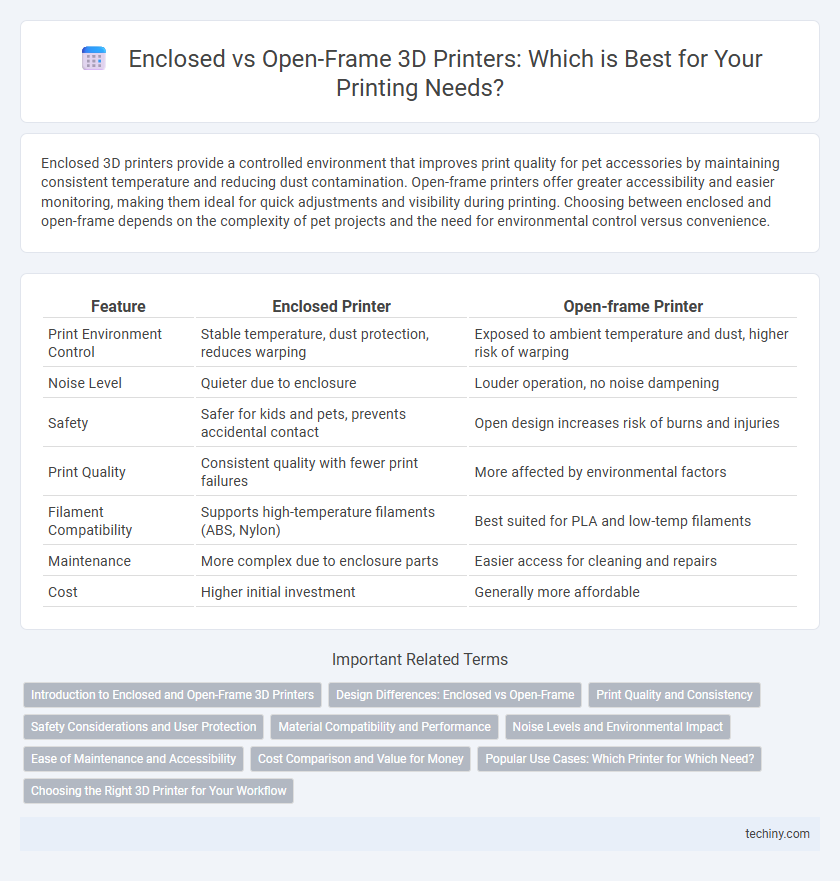Enclosed 3D printers provide a controlled environment that improves print quality for pet accessories by maintaining consistent temperature and reducing dust contamination. Open-frame printers offer greater accessibility and easier monitoring, making them ideal for quick adjustments and visibility during printing. Choosing between enclosed and open-frame depends on the complexity of pet projects and the need for environmental control versus convenience.
Table of Comparison
| Feature | Enclosed Printer | Open-frame Printer |
|---|---|---|
| Print Environment Control | Stable temperature, dust protection, reduces warping | Exposed to ambient temperature and dust, higher risk of warping |
| Noise Level | Quieter due to enclosure | Louder operation, no noise dampening |
| Safety | Safer for kids and pets, prevents accidental contact | Open design increases risk of burns and injuries |
| Print Quality | Consistent quality with fewer print failures | More affected by environmental factors |
| Filament Compatibility | Supports high-temperature filaments (ABS, Nylon) | Best suited for PLA and low-temp filaments |
| Maintenance | More complex due to enclosure parts | Easier access for cleaning and repairs |
| Cost | Higher initial investment | Generally more affordable |
Introduction to Enclosed and Open-Frame 3D Printers
Enclosed 3D printers feature a protective casing that stabilizes temperature and reduces exposure to dust, enhancing print quality and safety for materials like ABS and Nylon. Open-frame 3D printers offer easy access to the print area, making them ideal for quick adjustments and educational purposes but may struggle with maintaining consistent environmental conditions. Selecting between enclosed and open-frame designs depends on the specific printing needs, material types, and desired printing precision.
Design Differences: Enclosed vs Open-Frame
Enclosed 3D printers feature a protective casing that stabilizes temperature and shields prints from dust and external disturbances, enhancing print quality and safety. Open-frame printers have an exposed design that allows easier access to the print area, faster cooling, and simpler maintenance, but may compromise temperature control and increase exposure to environmental factors. The choice between enclosed and open-frame designs significantly impacts print precision, material compatibility, and user interaction during the printing process.
Print Quality and Consistency
Enclosed 3D printers maintain a stable internal temperature, reducing warping and layer separation, which enhances print quality and consistency, especially with ABS and other temperature-sensitive materials. Open-frame printers expose prints to ambient air fluctuations and dust, often resulting in inconsistent layer adhesion and dimensional inaccuracies. The controlled environment of enclosed printers significantly improves the reliability of complex, high-precision prints.
Safety Considerations and User Protection
Enclosed 3D printers provide enhanced safety by containing fumes, reducing the risk of burns from hot components, and preventing accidental contact with moving parts, making them ideal for home or educational environments. Open-frame printers expose users to potentially harmful emissions and hot surfaces, increasing the need for vigilant supervision and proper ventilation. Selecting an enclosed printer significantly mitigates health hazards and physical injuries during the printing process.
Material Compatibility and Performance
Enclosed 3D printers provide a controlled environment that supports printing with temperature-sensitive materials like ABS, Nylon, and Polycarbonate by maintaining stable heat and reducing warping. Open-frame printers excel in printing materials such as PLA, which require less thermal regulation, but may struggle with consistency when using high-performance filaments prone to cooling inconsistencies. Material compatibility and print performance improve significantly with enclosed printers when working with engineering-grade thermoplastics due to optimized temperature stability and reduced environmental interference.
Noise Levels and Environmental Impact
Enclosed 3D printers significantly reduce noise levels by containing sound within their housing, making them ideal for quiet environments, whereas open-frame printers tend to be louder due to exposed moving parts and fans. Enclosed printers also minimize environmental impact by controlling fumes and particles released during printing, which enhances safety and air quality, unlike open-frame models that allow direct exposure to emissions. Noise isolation and emission containment features in enclosed printers contribute to a more sustainable and user-friendly printing experience.
Ease of Maintenance and Accessibility
Enclosed 3D printers offer enhanced ease of maintenance by protecting internal components from dust and debris, reducing the frequency of cleaning and calibration. Open-frame printers provide superior accessibility, allowing users to quickly reach and adjust parts without disassembly, which accelerates troubleshooting and modifications. Selecting between enclosed and open-frame designs depends on prioritizing protection and cleanliness versus ease of direct access and manual intervention.
Cost Comparison and Value for Money
Enclosed 3D printers typically cost 20-40% more than open-frame models due to added components like heated chambers and safety features, enhancing print quality and material versatility. Despite the higher initial investment, enclosed printers offer better temperature control, reducing print failures and material waste, leading to long-term cost savings for professional and industrial users. Open-frame printers provide a more affordable entry point for hobbyists and beginners, but may incur higher indirect costs from potential print errors and limited environmental control.
Popular Use Cases: Which Printer for Which Need?
Enclosed 3D printers provide a controlled environment ideal for printing with temperature-sensitive materials like ABS and nylon, making them popular in professional prototyping and industrial applications where precision and reliability are crucial. Open-frame printers, favored by hobbyists and educators, offer easy access for quick modifications and are suited for printing PLA and other less demanding materials in settings such as schools and maker spaces. Choosing between enclosed and open-frame models depends on factors like material requirements, print quality expectations, and workspace conditions.
Choosing the Right 3D Printer for Your Workflow
Enclosed 3D printers offer enhanced temperature control and safety, making them ideal for printing with high-performance materials like ABS and nylon, which require stable environments to minimize warping. Open-frame printers provide easier access and visibility, suited for rapid prototyping and materials like PLA that do not demand strict thermal regulation. Selecting the right 3D printer depends on your specific workflow needs, including material compatibility, print quality requirements, and workspace safety considerations.
Enclosed Printer vs Open-frame Printer Infographic

 techiny.com
techiny.com